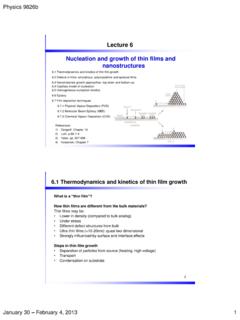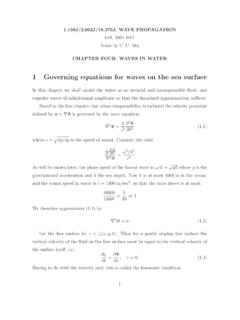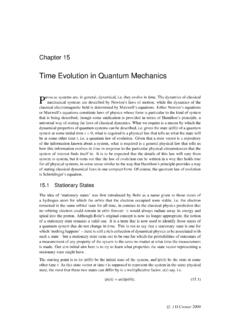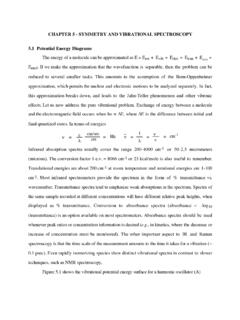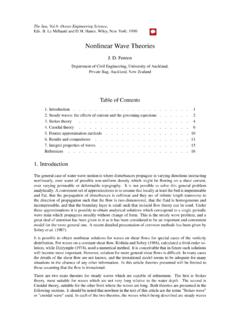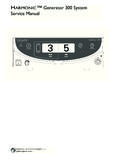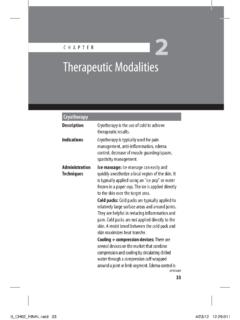Transcription of Mechanical Properties of Metals - Western University
1 11 chapter 6 chapter 6 Mechanical Properties of MetalsMechanical Properties refers to the behavior of material when external forces are appliedStressand strain fractureFor engineeringpoint of view: allows to predict the ability of a component or a structure to withstand the forces applied to itFor science point of view: what makes materials strong helps us to design a better new oneLearn basic concepts for Metals , which have the simplest behaviorReturn to it later when we study ceramics, polymers, composite materials, nanotubes2 chapter Elastic and Plastic Deformation metal piece is subjected to a uniaxial force deformation occurs When force is removed:- metal returns to its original dimensions elasticdeformation (atoms return to their original position)- metal deformed to an extent that it cannot fully recover its original dimensions plasticdeformation (shape of the material changes, atoms are permanently displacedfrom their positions)L0A0AL=L0+ LFF23 chapter Concept of Stress and StrainLoad can be applied to the material by applying axial forces:L0A0 Not deformedATensionL=L0+ LFFAC ompressionL=L0+ LFF L can be measured as a function of the applied force.
2 Area A0changes in response4 chapter 6 Stress ( ) and Strain ( )ABlock of metalL=L0+ LFFS tress ( ) defining F is not enough ( F and A can vary) Stress stays constant UnitsForce / area = N / m2 = Pausually in MPa or GPaStrain ( ) result of stress For tension and compression: change in length of a sample divided by the originallength of sampleAF= LL = 35 chapter 6 Shear and Torsion (similar to shear) Note: the forces are applied in this way, so that there is no net torque If the forces are applied alongthe faces of the material, they are called shear forcesL0A0 Not deformedL0A0 Pure shear SSSSL0 Torsion6 chapter 6 Shear Stress and Shear StrainIf the shear force S acts over an area A, the shear stress :)()_()_(areaAforceshearSstressshear= The shear strain is defined in terms of the amount of the shear displacement a divided by distance over which the shear acts: ==tanha 47 chapter 6 Elastic Properties of Materials Most materials will get narrow when stretched and thicken when compressed This behaviour is qualified by Poisson s ratio, which is defined as the ratio of lateraland axialstrain zyzxRatiosPoisson = =:_' the minus sign is there because usually if z> 0, and x+ y< 0 > 0 It can be proven that we must have.
3 = is the case when there is no volume changezyxzzyyxxlllllllll = + + +))()((8 chapter 6 Poisson s Ratio, For isotropic materials( material composed of many randomly - oriented grains) = For most < < If = 0 :means that the width of the material doesn t change when it is stretched or compressed Can be: < 0( the material gets thicker when stretched)59 chapter Modulus of elasticity, or Young s Modulus Stress and strain are Properties that don t depend on the dimensions of the material (for small ), just type of the material E Young s Modulus, Pa Comes from the linear range in the stress-strain diagram many is related to atomic bonding between the atoms< and live s Modulus [GPa]Material)()(strainstressE =10 chapter 6Q.:A wagon of mass m = 1100kg is suspended from the bridge by a steel cable of d = 1cm and length L = 10m. E(steel) = 2 1011Pa (a) By how much will the cable stretch?
4 (b) Can the cable handle this?611 chapter 6 Tensile Test1. Modulus of elasticity2. Yield strength at offset3. Ultimate tensile strength4. Percent elongation at fracture5. Percent reduction in area at fracture12 chapter 6 Other tensile test characteristics: Yield strength(at offset) Ultimate Tensile Strength(UTS): the maximum strength reached in the stress-strain curve Percent elongation at fracture (measure of ductilityof the metal ) Percent reduction in area at fractureLLEoriginalAF ==)( %100___% =initialfinalinitialAAAareainreduction71 3 chapter 6 True and Engineering StressLLEAF initialgengineerin == instanttrueAF= 14 chapter HardnessHardness:a measure of the resistance of a material to plastic (permanent) deformationMeasured by indentation indenter material (ball, pyramid, cone) is harder than the material being tested ( : tungsten carbide, diamond) indenter is pressed at 90o hardness is based on the depth of the impression or its cross-sectional areaSeveral common hardness tests.
5 Hardness numberscan be calculatedMaterial strength and hardness are relatedHardness test is nondestructive often used815 chapter 6 Hardness tests: hardness numbers16 chapter Plastic deformations of single crystal metalsA rod of a single crystal Zn (hcp) stressed beyond its elastic limit: slipbands: slip of metal atoms on specific crystallographic planes (slip planes) slip is predominatelyalong the basal planesA rod of a single crystal Cu (fcc) during plastic deformation: slip lines: 50-500 atoms apart slipbands: separated by ~>10,000 atomic planes917 chapter 6 Other Mechanical characteristics Ductility: amount of plastic deformation that occurs before fracture- if ductility is high, the material can be deformed by applying : gold- if it is low, material breaks first, without significant deformation (material is brittle)- depend on T: at low T many Metals become brittle and can break as a glass Resilience: ability to have high yield strength and low : good springs Toughness: ability to absorb energy up to a fracture18 chapter 6 Mechanism of Slip deformationthe group of atoms do NOT slide over each other during plastic shear deformation the process requires too much energyThe process takes less energy!
6 !!1019 chapter 6 Motion of DislocationsIn the metal slip mechanism, dislocations move through the metal crystals like wave fronts, allowing metallic atoms to slide over each other under low shear stress deformation without fracture20 chapter 6 Slip SystemsTypically slip planes are the most densely packed planes (less energy is required to move from one position to another), which are the farthest separatedCombination of a slip plane and a slip direction: slip system1121 chapter 6 Slip systems observed in crystal structuresFor hcpcrystals: 3 slip systems, restricts their ductility22 chapter 6 Schmid s LawSlip process begins within the crystal when the shear stress on the slip plane in slip direction reaches critical resolved shear stress chcp (Zn, Mg): , MPafcc (Cu): MPaplanesliprrAF_= cosFFr= cos_oplaneslipAA= coscoscoscoscoscos===oorAFAFS chmid s law1223 chapter 6Q.: A stress of 75 MPa is applied in the [0 01] direction on an fccsingle crystal.
7 Calculate (a) the resolved shear stress acting on the (111) [-101] slip system and, (b) (b) the resolved shear stress acting on the (111) [-110] slip 6 Mechanical TwinningAnother important plastic deformation mechanism (low T)from G. GottsteinSchematic diagram of surfaces of a deformed metal after (a) slip and (b) twinning1325 chapter Plastic Deformations in Polycrystalline Metals Majority of engineering alloys and Metals are polycrystalline Grain boundaries act as diffusion barriers for dislocation movements In practice: fine grain materials are stronger and harder (but less resistant to creep and corrosion) Strength and grain size are related by Hall-Pelchequation:dkoy+= oand k constantsas grain diameter decreases, the yield strength of the material increases26 chapter 6 Pile-up of dislocationsSchematicObserved in stainless steel (TEM)Grain shape changes with plastic deformationDislocation arrangement changes 1427 chapter Cold Plastic Deformation for Strengthening of Metals The dislocation density increases with increased cold deformation New dislocations are created by the deformation and must interact with those already existing As the dislocation density increases with deformation, it becomes more and more difficult for the dislocations to move through the existing dislocations Thus the metal work or strain hardens with cold deformationPercent cold work versus tensile strength and elongation for unalloyed oxygen-free copperCold work is expressed as a percent reduction in cross-sectional area of the metal being Superplasticity in MetalsSuperplasticity: the ability of some Metals to deform plastically by 1000-2000% at high temperature and low loading ratesEx.
8 : Ti alloy (6Al 4V) 12% @ RT, typical tensile test load rates~1000% @ 840oC, lower loading material must possess very fine grain size (5-10mm) and be highly strain-rate high loading T (> Tm) is low and controlled strain rate in the range of s-1 is required1529 chapter 6 Nanocrystalline Metals Nanocrystalline Metals : d < 10-50nm Consider Cu: o= 25 MPa, k = MPa (from Table )dkoy+= ? ++= MPaMPaMPaMPamnm Is this possible?Different dislocation mechanism: grain boundary sliding, diffusion, etc30 chapter 6 Summary Introduced stress, strain and modulus of elasticity Plastic deformations of single crystal Metals - In the single crystal metal - slip mechanism: dislocations move through the metal crystals like wave fronts, allowing metallic atoms to slide over each other under low shear stress -Slip process begins within the crystal when the shear stress on the slip plane in slip direction reaches critical resolved shear stress c-Schmid slaw: Plastic deformations in polycrystalline Metals - Strength and grain size are related by Hall-Pelch equation: Nanocrystalline materialsAF= )()(strainstressE =LL = dkoy+= coscoscoscoscoscos===oorAFAF

